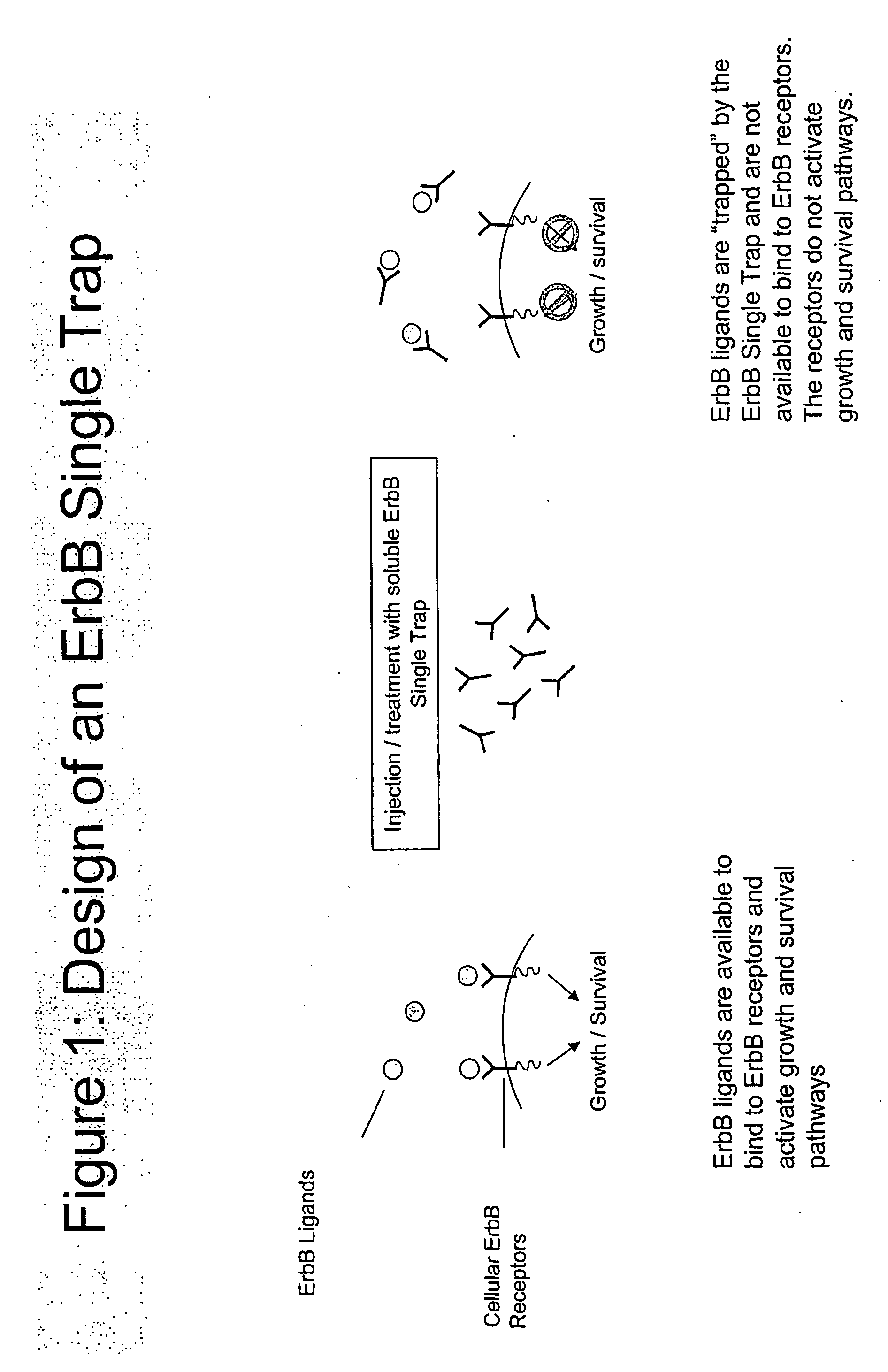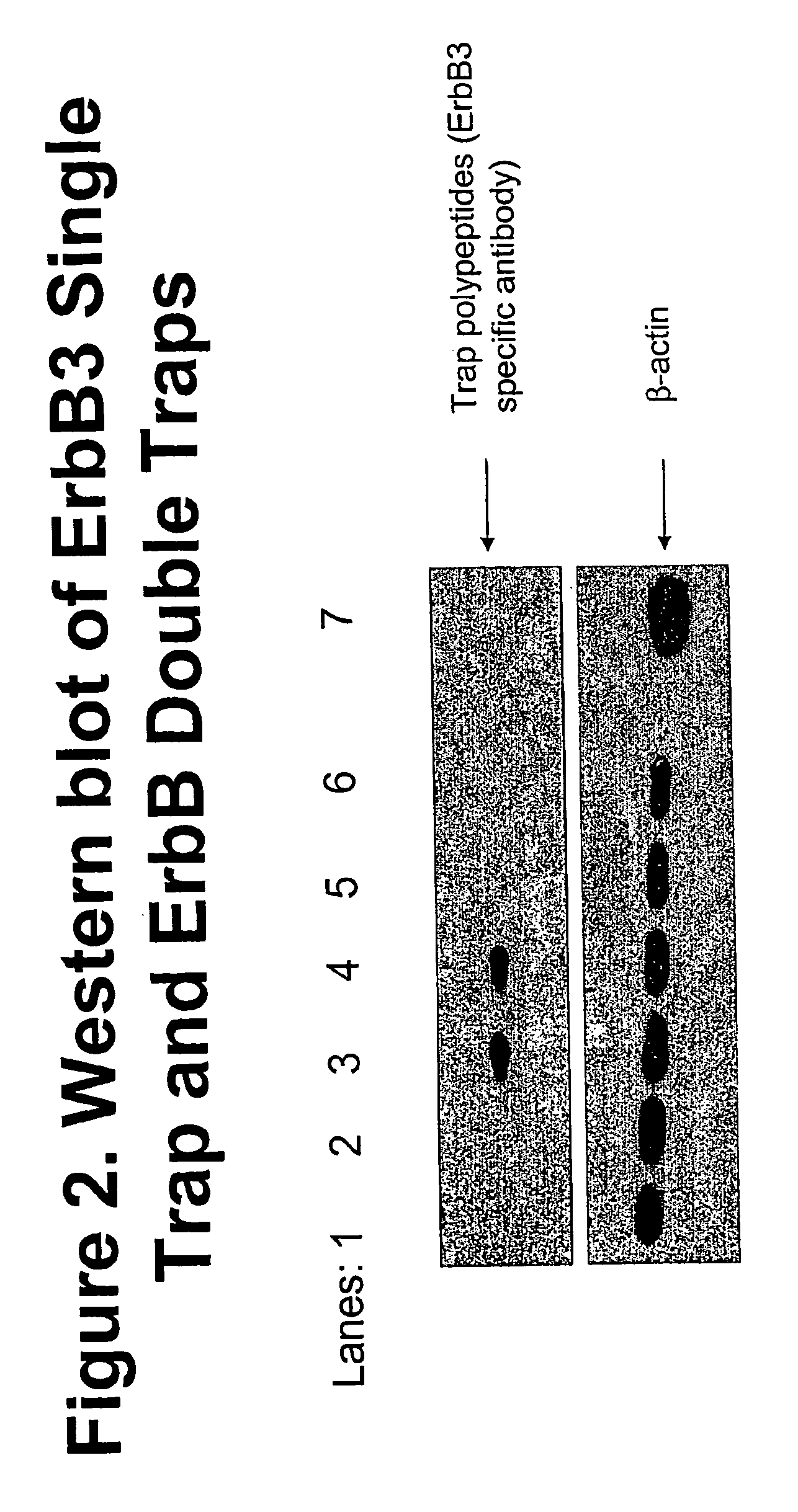Tyrosine kinase inhibitor compositions and methods for manufacturing and using them in the treatment of disease
a technology of tyrosine kinase and composition, which is applied in the field of receptor tyrosine kinases and their activation ligands, can solve the problem of not being able to bind to cellular erbb receptors
- Summary
- Abstract
- Description
- Claims
- Application Information
AI Technical Summary
Problems solved by technology
Method used
Image
Examples
example 1
[0037]The present example demonstrates the construction of one representative composition of a single trap molecule having an ErbB receptor extracellular domain, an ErbB3 extracellular domain in a single recombinant genetic construct.
[0038]The ErbB single trap can be designed to bind to different ligands of the ErbB family by incorporating the extracellular domains of either ErbB1, ErbB3 or ErbB4.
[0039]A truncated form of ErbB3 was cloned into the pEF-IRES-P plasmid by Dr. Yosef Yarden's laboratory at the Weizmann Institute in Rehovot, Israel. This construct consists of the first three extracellular domains of ErbB3 called LI (domain I), SI (domain II), LII (domain III) and a portion of SII (domain IV). Other protein domains fused to the 3′ end of this fragment include a PKA phosphorylation site, a Factor Xa cleavage site, and the Fc fragment of human IgG1 attached to the 3′ end. This entire fragment was then cloned into the NheI-NotI sites of the pEF-IRES-P plasmid to yield the pEF...
example 2
[0043]This example demonstrates expression of a double trap molecule from a recombinant DNA molecule in a mammalian host cell and its purification in active form. The pEF-ECD3IgG-IRES-P plasmid, pEF-ECD3-IRES-P plasmid and pEF-IRES-P control plasmid were separately transfected into 293T cells, which were then selected on puromycin in order to generate a population of cells with stable integration of the plasmid. These transduced cells secrete the ECD3IgG and ECD3 Single Trap polypeptides into the culture medium.
[0044]The results of the western blot from the transfected 293T cells (FIG. 2) demonstrated that the ErbB3 Single Trap was not recognized by an ErbB3 specific antibody (lane 1), however polypeptides that express the soluble ErbB3 and soluble ErbB1 from the same polypeptide were detected by the antibody (lanes 3 and 4). These polypeptides are called ErbB Double Traps because they contain extracellular ligand binding portions of 2 different ErbB extracellular ligand binding dom...
example 3
[0045]To test the functionality of the ErbB3 Single Traps, conditioned medium from the 293T cells was collected, filtered and used to culture BT474 breast cancer cells. A significant reduction in cell number was observed after 48 hrs in the BT474 cells cultured with medium from 293T cells that express the pEF-ECD3-IRES-P plasmid compared with cells that were cultured with conditioned medium from 293T cells that express the pEF-IRES-P control vector.
PUM
| Property | Measurement | Unit |
|---|---|---|
| body weight | aaaaa | aaaaa |
| binding affinity | aaaaa | aaaaa |
| soluble | aaaaa | aaaaa |
Abstract
Description
Claims
Application Information
 Login to View More
Login to View More - R&D
- Intellectual Property
- Life Sciences
- Materials
- Tech Scout
- Unparalleled Data Quality
- Higher Quality Content
- 60% Fewer Hallucinations
Browse by: Latest US Patents, China's latest patents, Technical Efficacy Thesaurus, Application Domain, Technology Topic, Popular Technical Reports.
© 2025 PatSnap. All rights reserved.Legal|Privacy policy|Modern Slavery Act Transparency Statement|Sitemap|About US| Contact US: help@patsnap.com


